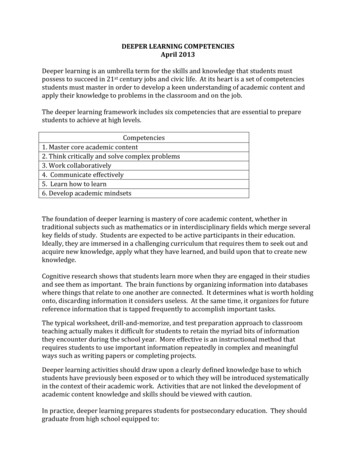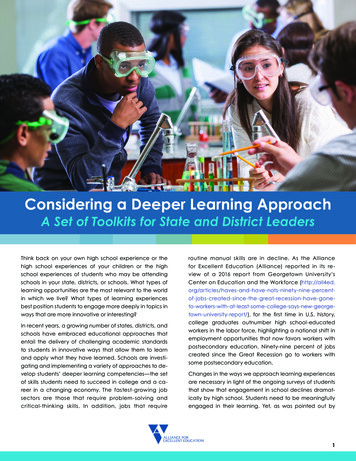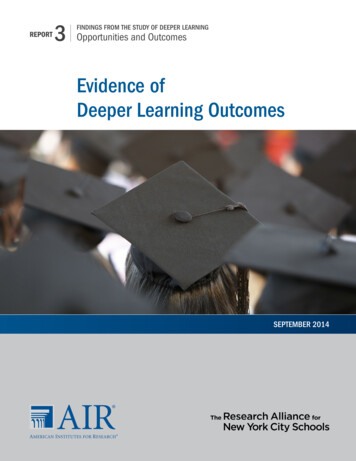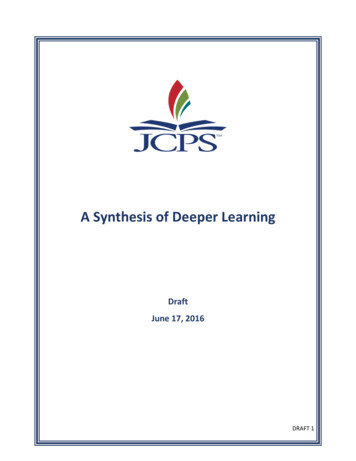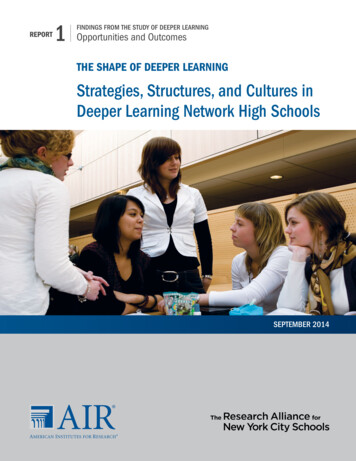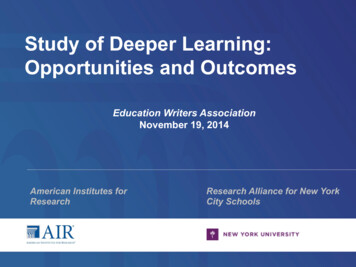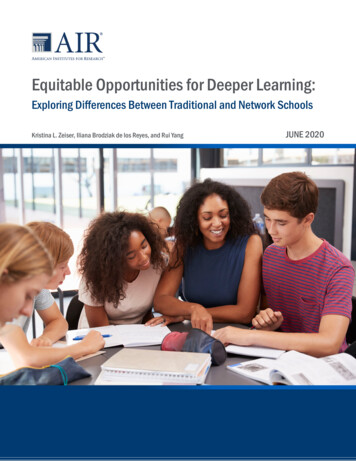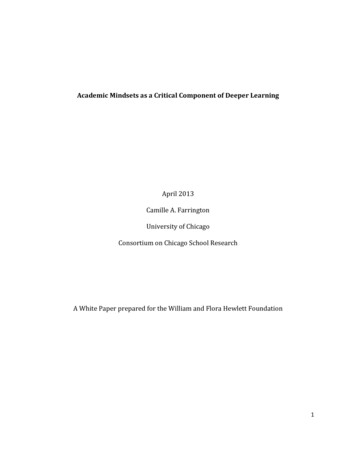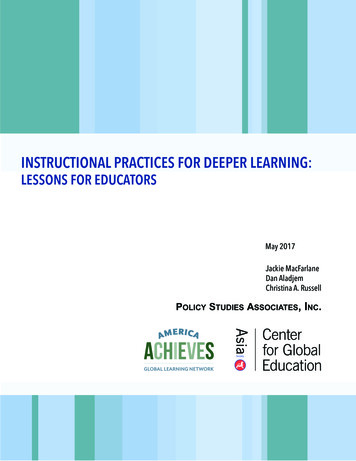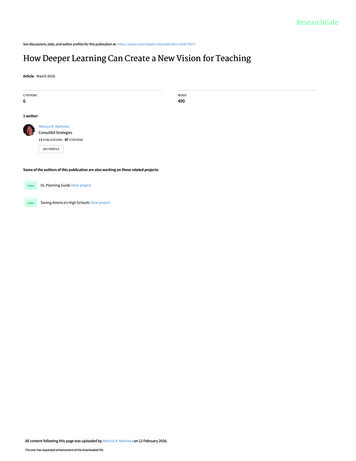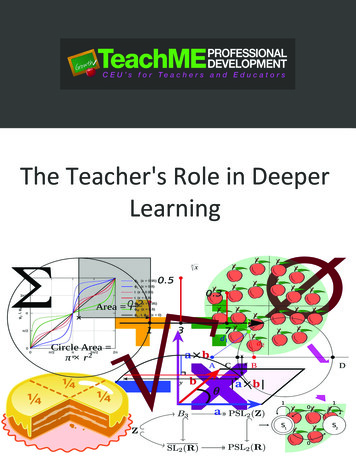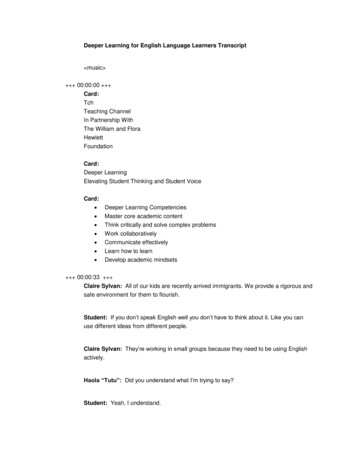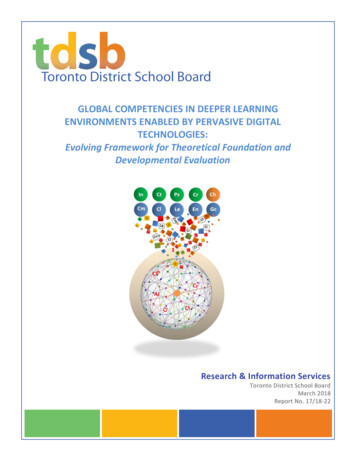
Transcription
GLOBAL COMPETENCIES IN DEEPER LEARNINGENVIRONMENTS ENABLED BY PERVASIVE DIGITALTECHNOLOGIES:Evolving Framework for Theoretical Foundation andDevelopmental EvaluationResearch & Information ServicesToronto District School BoardMarch 2018Report No. 17/18-22
TITLE: Global Competencies in Deeper Learning Environments Enabled by Pervasive DigitalTechnologies: Evolving Framework for Theoretical Foundation and Developmental EvaluationAUTHORS: Erhan Sinay and Dimitris GraikinisWe would like to thank and acknowledge the support and contributions of Thomas G. Ryan,Professor, Faculty of Education, Nipissing University for this studyCopyright Toronto District School Board (March 2018)Cite as:Sinay, E., & Graikinis, D. (2018). Global competencies in deeper learning environments enabledby pervasive digital technologies: Evolving framework for theoretical foundation anddevelopmental evaluation. (Research Report No. 17/18-22). Toronto, Ontario, Canada: TorontoDistrict School BoardNote: As an evolving model most of the content of this manuscript has also been submitted tothe “Journal of Research on Technology in Education” on October 24, 2017Reproduction of this document for use in the schools of the Toronto District School Board isencouraged.For any other purpose, permission must be requested and obtained in writing from:Research & Information ServicesToronto District School Board1 Civic Centre Court, Lower LevelEtobicoke, ON M9C 2B3Fax:416-394-4946Every reasonable precaution has been taken to trace the owners of copyrighted material and tomake due acknowledgement. Any omission will gladly be rectified in future printings.R02(STEM\2016-17\Deep Learning and GC Reports\Research Series 10 DLGCDF Framework\DLGCDF Framework)es.1485
TABLE OF CONTENTSIntroduction . 1Importance and Need of Deeper Learning Environments, Global Competencies, andDigital Fluency . 1Deeper Learning Environments: Production of Transferable Knowledge . 3Pedagogies, Principles, and Strategies of Deeper Learning .4Technology, Deeper Learning Pedagogy, and Content .4Deeper Learning Practices .6Global Competencies: Transferable Types of Knowledge Which Leads to Action . 8What are Global Competencies? .9Types of Global Competencies .9Criteria for Defining Global Competencies at the TDSB .11Definitions of TDSB Global Competencies .12Digital Fluency: Empowering Learners with Pervasive Digital Technologies to ProduceWorks of Significance . 15Evolution of Terminology in Technology-Enabled Learning: From Digital Literacyto Competency to Fluency .16Digital Fluency at the Toronto District School Board .17Digital Fluency is a Fundamental Educational Outcome . 18Description of Digital Fluency .18Three Stages to Digital Fluency .19Structure: The Essential Competencies of Digital Fluency .19Strands: Further Information .22Developmental Nature of Digital Fluency .25References . 28APPENDICESAppendix A: Definitions Used in the Framework .35i
ii
IntroductionThe Toronto District School Board (TDSB) has recentlyintroduced A Vision for Learning in the TDSB, to“enable all students to reach high levels ofachievement and to acquire the knowledge, skills, andvalues they need to become responsible members of ademocratic society” (TDSB, 2017, About Us, OurStudents, para. 1). In response to a growing body ofevidence regarding the importance of students’ digitalaptitudes in an information society, this frameworkembraces digital fluency and has been integrated as acore 21st century outcome, equal in importance to thetraditional cores of literacy and numeracy. In the sameframework, 10 global competencies support the core21st century outcomes for graduating TDSB students.Figure 1: TDSB Vision for LearningSource: (Malloy, 2016, p. 11)Importance and Need of Deeper Learning Environments, GlobalCompetencies, and Digital FluencyIn today’s changing environments within school settings, increased attention is geared towardseffective learning. There is a sense of urgency for innovation in education which arises as partof rapid economic and societal changes. What is the most effective teaching approach forschools to prepare students for success in the future? What kinds of environments create andsustain new competencies students require to learn in order to succeed in a world where thenature of the problems is changing? What is the role of technology in shaping the teaching andlearning environments?There is an abundance of evidence within the literature which suggests that effective teachingapproaches, like deep learning, will help students today, while supporting competencies gainedin the learning process, which includes digital technologies in the teaching and learning process.The purpose of this report is To briefly review the research literature on the the relationship between deeperlearning, global competencies, and digital fluency, all of which change the learningprocess of our students. We argue that learning environments where globalcompetencies are refined by deeper learning and supported by pervasive digitaltechnologies enable TDSB students to achieve high levels of literacy, numeracy, andGLOBAL COMPETENCIES IN DEEPER LEARNING ENVIRONMENTS ENABLED BY PERVASIVE DIGITAL TECHNOLOGIES:Evolving Framework for Theoretical Foundation and Developmental Evaluation1
digital fluency. This work provides clarification of the basic features of the three areasresearched including, the interrelationships and forms the basis for the development ofdeeper learning, global competencies and digital fluency in subsequent steps.Figure 2: Next StepsThis work builds on previous work completed by the Research and Information ServicesDepartment and it is informed by the preliminary results of those studies1.1Please see the reports on Technology and Innovation in Education AL COMPETENCIES IN DEEPER LEARNING ENVIRONMENTS ENABLED BY PERVASIVE DIGITAL TECHNOLOGIES:Evolving Framework for Theoretical Foundation and Developmental Evaluation
Deeper Learning Environments:Production of Transferable KnowledgeAt the Toronto District School Board (TDSB), we view deeper learning situations as theenvironments where a set of instructional approaches are aligned with three core learningfoundations across academic subjects. These core learning foundations suggest studentlearning takes place when students are:a. Meaningfully engaged;b. Presented with factual knowledge organized around a conceptual framework; andc. Taught in their learning environment using metacognitive practices (Donovan &Bransford, 2005; Bransford, 2000 - as cited in Dede & Frumin, 2016; Organization forEconomic Co-operation and Development, 2010).Deeper learning is a complex, intricate, and multifaceted instructional approach; it isconstructivist in nature addressing the subjective (internal) nature of learning; it refers to thelearners experiences directed to the student using active techniques (authentic, real-worldproblem solving) (Rillero, 2016). Putting the student in the center of the learning processreflects “a profound respect for who students are and whatthey can do” (Mehta & Fine, 2015, p. 33). Deeper learning isApplying learned knowledge incharacterized by learning that sticks (Fullan, 2017), becausenew situations (transferableknowledge) and the developmentit changes the teacher-student relationship and theof new competencies are thepedagogy used in the classroom. Similarly, for Mehta andmain components in definitions ofFine (2015), deeper learning emerges at the crossroads ofdeep learning.mastery of the content, intrinsic motivation (identity), andaction or making something new within the field (creativity).Deeper learning is associated with “the ability to transferknowledge” (p. 4).Deeper learning takes placewhen students are immersed inlearning environments rich inopportunities for criticalthinking, collaboration,creativity, communication, andautonomous learning.The importance of the metacognitive component of deeperlearning is emphasized above all other factors in a widerange of studies. It appears that students who self-regulateneed to be engaged in metacognition, that is, thinkingabout one’s own cognition (Metcalfe, 2000; Norman &Furnes, 2016). Metacognitive processes are cultivated byengaging students in problem-based learning and peercollaborative environments where they have theopportunities to reflect on new concepts. Only under theseconditions are they able to graft new knowledge to theirGLOBAL COMPETENCIES IN DEEPER LEARNING ENVIRONMENTS ENABLED BY PERVASIVE DIGITAL TECHNOLOGIES:Evolving Framework for Theoretical Foundation and Developmental Evaluation3
existing cognitive framework. “Once new learning is integrated into existing ‘ways of knowing’,this in turn nurtures creativity and originality and establishes new cognitive habits. Criticalthinking skills are also enhanced” (Lai, 2011a, as it is cited in UNESCO, 2015, p. 3). Engagingstudents in metacognitive processes appears to enhance transferable knowledge, (i.e., applyingknowledge acquired in new situations and contexts).Pedagogies, Principles, and Strategies of Deeper LearningThere is agreement among experts in the field for the effectiveness of deeper learning as aninstructional approach and for its key pedagogies, principles, and strategies (American Institutefor Research, 2017; Dede & Frumin, 2016; Fullan & Langworthy, 2013; Hewlett Foundation,n.d.; Mehta & Fine, 2015; National Research Council [NRC], 2012; OECD, 2010; OECD, 2017a).The backbone of deeper learning is the formation of new partnerships between and amongstudents and the teacher, which leads to a student-centered instructional approach (the “newpedagogies” in praxis, according to Fullan & Donnelly, 2013; UNESCO, 2015). In student-centriclearning environments, students take greater control of their learning and teachers are calledto apply pedagogical competency by acting as “aggregators, amplifiers, and facilitators ofknowledge, and [by] focusing on the cultivation of connectivity and inter‐sections betweendifferent nodes of information or knowledge which extend beyond the classroom environment”(Sinay, 2014, p. 14; Apelgren & Giertz, 2010).In a seminal paper prepared for UNESCO (2015), the author argues that the new competenciesrequired by today’s students can’t be taught by the traditional “transmission” or “lecturemodel”. UNESCO advocates for new effective pedagogies which need to be adopted for studentlearning and which engage students in the learning processes that support new competencieslinked to the cognitive domain. Pedagogy 2.0 redefines the teaching and learning process atboth ends: teachers assume new roles and act as facilitators of knowledge; whereas, studentscontribute to course content by idea production and active performance.Technology, Deeper Learning Pedagogy, and ContentOECD’s (2017b) pedagogical core includes the dynamic interplay between teachers, learners,resources, and content. Subject-specific knowledge and deeper learning pedagogicalknowledge are the main teacher-related determinants for effective teaching (OECD, 2016a). Atthe TDSB we adopted the Technological Pedagogical Content Knowledge (TPACK) model whichintegrates subject-specific knowledge, pedagogical knowledge together with technologicalknowledge, as the pedagogical framework to be used in deeper learning environments (Mishra& Koehler, 2006; Schmidt et al., 2009). Subject-specific knowledge and technological knowledgeare easily defined but cultural differences infusing perspectives on the role of teachers and4GLOBAL COMPETENCIES IN DEEPER LEARNING ENVIRONMENTS ENABLED BY PERVASIVE DIGITAL TECHNOLOGIES:Evolving Framework for Theoretical Foundation and Developmental Evaluation
schooling “should be taken into account while defining the concept of pedagogical knowledge”(OECD, 2017b, p. 107). Technology, deeper learning pedagogy, and content are the three areasof knowledge covered by TPACK which builds on a previous construct developed by Shulman(1986). The model allows for the integration of the Technological into the Pedagogical andContent Knowledge required in teaching and it can be applied across disciplines. Each of thethree individual knowledge areas interact to produce Pedagogical Content Knowledge (PCK),Technological Content Knowledge (TCK), Technological Pedagogical Knowledge (TPK), andTechnological Pedagogical Content Knowledge (TPACK) (see Figure 3)Figure 3: The TPACK ModelSource: Mishra and Koehler (2006); Reproduced by permission.In order for students to cultivate global competencies, the following principles, strategies andpedagogical approaches have been adopted within TDSB’s deeper learning environments (seeTables 1, 2, and 3).Table 1: Principles for Deeper Learning Environments for the Cultivation of Global Competencies atTDSB Schools (Saavedra & Opfer, 2012; OECD, 2016b)12345678910Principles of Deeper Learning EnvironmentsAdopt learner-centered modelsMake learning relevant to the ‘big picture’Teach through the disciplinesAdopt new pedagogiesDevelop lower and higher order thinking skillsEncourage transfer of learningTeach how to ‘learn to learn’ or metacognitionPromote teamworkExploit technology to support learningFoster students’ creativityGLOBAL COMPETENCIES IN DEEPER LEARNING ENVIRONMENTS ENABLED BY PERVASIVE DIGITAL TECHNOLOGIES:Evolving Framework for Theoretical Foundation and Developmental Evaluation5
Table 2: Strategies for Deeper Learning Environments for the Cultivation of Global Competencies atTDSB Schools (NRC, 2012)1234567Strategies of Deeper Learning EnvironmentsUsing multiple and varied representations of concepts and tasksEncouraging elaboration, questioning and explanationUsing multiple and varied representations of concepts and tasksEngaging learners in challenging tasksTeaching with examples and casesPriming student motivationUsing formative assessmentsTable 3: Pedagogical Approaches Contributing to Deeper Learning Environments for theCultivation of Global Competencies at TDSB Schools (UNESCO, 2015)12345678910111213Pedagogical Approaches Contributing to Deeper LearningFocusing on qualityFostering participationFocusing personalization and customization of learningEmphasizing project and problem-based active learningEncouraging collaboration and communicationEngaging learnersEmploying appropriate learning toolsDesigning relevant and real-world learning activitiesIncluding every learner through technologyPromoting learning without borders (anytime and anywhere)Encouraging lifelong learningAssessing for deeper understanding and competencyRedefining teacher roles and functionsDeeper Learning PracticesThe main idea behind deep learning practices is that students learn better when they aredeeply engaged and have an enhanced grasp of the learning process. The focus is shifted frompassively acquiring knowledge to active discovery of content and meaning by exploring andsolving real world problems. This new approach to learning is better suited for modern learners,as it provides students with learning skills that help them compete effectively in a globalized,interconnected, and technology-infused world.In this new learning environment, classrooms become student-centric learning environments,with students taking greater control of their learning and teachers acting as partners,collaborators, and facilitators to help guide students through the process of learning how tolearn. The relationship between the classroom and external world is also changing, as studentsbecome virtually connected to and immersed in the world beyond the classroom and school.Deeper learning is being applied in the classroom through a focus on problem and inquiry-6GLOBAL COMPETENCIES IN DEEPER LEARNING ENVIRONMENTS ENABLED BY PERVASIVE DIGITAL TECHNOLOGIES:Evolving Framework for Theoretical Foundation and Developmental Evaluation
based learning, where students work in project teams focused on solving complex andauthentic real-world problems while using and improving their literacy and numeracy skills.Experiences produced in deeper learning environments, intrinsically motivate the studentsgenerating meaningful engagement which further leads through the accumulation, integration,and interpretation of experience to their identity development. Identity building fuels“learners’ perceptions about the relevance of content and the way that learning becomesdeeper as it becomes a more core part of self” (Mehta & Fine 2015, p. 6).The effectiveness of teaching in deeper learning environments appears to relate to a variety ofteaching practices which in turn is highly correlated to high-quality teacher professionaldevelopment (TPD). In addition, curriculum-focused TPD appears to be more important thansubject matter-focused TPD and “the greater the collaboration in TPD, the better the practicesin the classroom” (OECD, 2016c, p. 14).In summary, deep learning practices expose the students to new pedagogies in authenticlearning environments which stimulate meaningful engagement and mastering of transferableknowledge. The deeper learning environments cultivate a number of knowledge, skills, andattitudes which are labelled global competencies. The main attributes of deeper learningenvironments are depicted in Figure 4.Figure 4: Main Attributes of Deeper Learning Environments Addressing How Students eredBig-picture Through disciplines New pedagogies Thinking skills Transfer of learning Metacognition Teamwork Technology use Creativity Intrinsic motivation InstructionalStrategiesMultiple, variedrepresentations Elaboration,questioning,explanation Challenging tasks Examples, cases Formativeassessments Meaningful engagement Opportunitiesfor GrowthCritical thinkingCollaboration Creativity Communication Autonomouslearning Identity developmentGLOBAL COMPETENCIES IN DEEPER LEARNING ENVIRONMENTS ENABLED BY PERVASIVE DIGITAL TECHNOLOGIES:Evolving Framework for Theoretical Foundation and Developmental Evaluation7
Global Competencies:Transferable Types of Knowledge Which Leads to ActionThere is little disagreement among experts that subject-specific knowledge together withcompetencies combine to sustain success in life and improve our future economy. Today, morethan ever before, intrapersonal and interpersonal competencies are viewed by educationalpsychologists as important factors in the learning process an
deeper learning, global competencies and digital fluency in subsequent steps. Figure 2: Next Steps This work builds on previous work completed by the Research and Information Services Department and it
